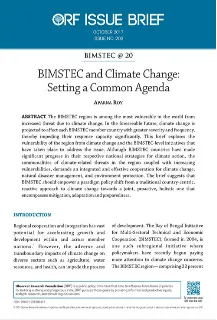In view of the climate threats in the region and the transboundary nature of their impact, BIMSTEC members must embark on an ambitious climate action through regional cooperation. Several risk factors create an impact on pairs, at the least, or even larger combinations of countries in the region, wherein adaptation and mitigation efforts may be rendered unviable if each country follows a purely domestic and insulated approach. [xliv] Given that BIMSTEC is being revitalised today, two decades since its establishment, this presents an opportunity for BoB countries to apply the lessons learned from the experiences of groupings such as SAARC and ASEAN.
At the global level, the presentation of a BIMSTEC common position at various UNFCCC COPs is an important step forward in raising a regional voice. BIMSTEC must also ensure in a strategic way that the voice of the BoB region as a whole is heard and their genuine concerns are taken on board. [xlv] While creating a common position, it is important that BIMSTEC member countries include the concerns of various stakeholders, such as the government, private sector, civil society as well as academia.
At the regional level, the principal step would be to devise a comprehensive BIMSTEC climate action plan, reflecting a clear strategy to integrate mitigation and adaptation in all the development programmes of member nations. There is a need to adopt a multi-hazard and multi-sectoral approach and work towards common outcomes through the institutionalisation of partnerships across all levels of governance.
BIMSTEC could initiate the institutional process of addressing regional climate-related issues through cost-effective knowledge solution at the national and local levels, wherein formation of BIMSTEC groups and task forces on ecosystem, biodiversity, migration, extreme weather events and health could be a way forward. In addition, key initiatives such as energy cooperation through trade in green technologies, advanced energy generation through renewable sources, promoting clean energy practices and benchmarking performances could be a significant step for the evolution of BIMSTEC. [xlvi]
Furthermore, initiatives would need to be reinforced by policy coordination at all levels—regional, national, and local. Considering the complexities involving intra- and inter-governmental coordination involving several governments, states, sub-national departments in various sectors, a task force could be constituted to identify gaps and integrate national action plans of member nations. [xlvii]
The key to the success of BIMSTEC’s efforts at mitigating climate-change issues would hinge on devising an impact monitoring mechanism. Member states will also have to agree on measurable targets to assess the achievements in their adopted goals.
Finally, it is crucial for BIMSTEC to transform its approach by recognising and overcoming the differences between member states. India’s divergences over transboundary Teesta river water-sharing with Bangladesh, and the recent Rohingya refugee crisis between Myanmar and Bangladesh, are cases in point. However, member nations must recognise that considering their regional setting and geographical proximity, the security of states in the sub-region is contingent upon each other. Climate action would thus need to be prioritised as a common security agenda.
Endnotes
[i]Coastal Association for Social Transformation (COAST) Trust. Climate Change in the Bay of Bengal Region: Exploring Sectoral Cooperation for Sustainable Development edited by Mr. Rezaul Karim Chowdhury. Dhaka, 2016. Available at: http://bbforum.net/wp-content/uploads/2017/02/BIMSTEC-Book-on-Climate-Change-Final.pdf
[ii] Rahman, Mohammad Masudur, and Chanwahn Kim. “Prospects for Economic Integration of BIMSTEC: Trade and Investment Scenario.” International Journal of u-and e-Service, Science and Technology 9, no. 4 (2016): 235-248.
[iii] “Risk calculator and dashboard.” Verisk Maplecroft. https://maplecroft.com/about/news/ccvi.html
[iv] ThinkAhead Limited and Concern Worldwide .Climate Change in the Coast of Bay of Bengal: Impact, Resilience and Implication – Summary Report and Call for Action – Summary Report and Call for Action prepared by Khurshid Alam and Saroj Dash. Concern Worldwide, 2011. Available at: https://www.concern.net/resources/bangladesh-climate-change-coast-bay-bengal
[v] Coastal Association for Social Transformation (COAST) Trust. Climate Change in the Bay of Bengal Region: Exploring Sectoral Cooperation for Sustainable Development edited by Mr. Rezaul Karim Chowdhury. Dhaka, 2016. Available at: http://bbforum.net/wp-content/uploads/2017/02/BIMSTEC-Book-on-Climate-Change-Final.pdf
[vi] Frost, Ellen L. “It’s Time to Deepen Integration Around the Bay of Bengal.” May 31, 2017. Accessed September 29, 2017. http://carnegieindia.org/2017/05/31/it-s-time-to-deepen-integration-around-bay-of-bengal-pub-70128
[vii] Kabir, M.H. and Ahmad, A. “The Bay of Bengal: Next theatre for strategic power play in Asia.” Croatian International Relations Review, 21(72), (2015) pp.199-238.
[viii] Das, Kasturi, and Kaushik Ranjan Bandyopadhyay. “Climate Change Adaptation in the Framework of Regional Cooperation in South Asia.” Carbon & Climate Law Review 9, no. 1 (2015): 40-54. Available at: https://www.jstor.org/stable/43859672?seq=1#page_scan_tab_contents
[ix] South Asia Region Sustainable Development Department. The World Bank. “South Asia: Shared Views on Development and Climate Change.” Washington, 2009. Available at: http://siteresources.worldbank.org/SOUTHASIAEXT/Resources/Publications/448813-1231439344179/5726136-1259944769176/SAR_Climate_Change_Full_Report_November_2009.pdf
[x]Coastal Association for Social Transformation (COAST) Trust. Climate Change in the Bay of Bengal Region: Exploring Sectoral Cooperation for Sustainable Development edited by Mr. Rezaul Karim Chowdhury. Dhaka, 2016. Available at: http://bbforum.net/wp-content/uploads/2017/02/BIMSTEC-Book-on-Climate-Change-Final.pdf
[xi]Das, Kasturi, and Kaushik Ranjan Bandyopadhyay. “Climate Change Adaptation in the Framework of Regional Cooperation in South Asia.” Carbon & Climate Law Review 9, no. 1 (2015): 40-54. Available at: https://www.jstor.org/stable/43859672?seq=1#page_scan_tab_contents
[xii]Chaturvedi, Sanjay, and Vijay Sakhuja. Climate change and the Bay of Bengal: evolving geographies of fear and hope. ISEAS-Yusof Ishak Institute. (2015)
[xiii] Sahni, Pardeep., Dhameja, Alka., and Medury, Uma. MEDURY. Disaster mitigation: experiences and reflections. PHI Learning Pvt. Ltd., 2001.
[xiv] Townsley, Philip. “Review of coastal and marine livelihoods and food security in the Bay of Bengal Large Marine Ecosystem Region.” Bay of Bengal Large Marine Ecosystem Programme (2004). http://www.boblme.org/documentRepository/Theme_livelihoods%20-%20Townsley.pdf
[xv] Das, Kasturi, and Kaushik Ranjan Bandyopadhyay. “Climate Change Adaptation in the Framework of Regional Cooperation in South Asia.” Carbon & Climate Law Review 9, no. 1 (2015): 40-54. Available at: https://www.jstor.org/stable/43859672?seq=1#page_scan_tab_contents
[xvi] Vivekanandan, Elayaperumal, Rudolf Hermes, and Chris O’Brien. “Climate change effects in the Bay of Bengal large marine ecosystem.” Environmental Development 17 (2016): 46-56. Available at: http://www.undp.org/content/dam/undp/library/Environment%20and%20Energy/Water%20and%20Ocean%20Governance/Frontline%20Observations%202012.pdf
[xvii] ibid.
[xviii]Das, Kasturi, and Kaushik Ranjan Bandyopadhyay. “Climate Change Adaptation in the Framework of Regional Cooperation in South Asia.” Carbon & Climate Law Review 9, no. 1 (2015): 40-54. Available at: https://www.jstor.org/stable/43859672?seq=1#page_scan_tab_contents
[xix] Chaturvedi, Sanjay, and Vijay Sakhuja. Climate change and the Bay of Bengal: evolving geographies of fear and hope. ISEAS-Yusof Ishak Institute, 2015.
[xx] ibid.
[xxi] ibid.
[xxii] Ibid.
[xxiii] Kelkar, Ulka, and Suruchi Bhadwal. “South Asian regional study on climate change impacts and adaptation: implications for human development.” Human development report 2008 (2007). Available at: http://csf.rrojasdatabank.info/kelkar_ulka%20and%20bhadwal_suruchi.pdf
[xxiv] Das, Kasturi, and Kaushik Ranjan Bandyopadhyay. “Climate Change Adaptation in the Framework of Regional Cooperation in South Asia.” Carbon & Climate Law Review 9, no. 1 (2015): 40-54. Available at: https://www.jstor.org/stable/43859672?seq=1#page_scan_tab_contents
[xxv] Ahmed, Mahfuz, and Suphachol Suphachalasai. Assessing the costs of climate change and adaptation in South Asia. Asian Development Bank, 2014.
[xxvi] Vivekanandan, Elayaperumal, Rudolf Hermes, and Chris O’Brien. “Climate change effects in the Bay of Bengal large marine ecosystem.” Environmental Development 17 (2016): 46-56. Available at: http://www.undp.org/content/dam/undp/library/Environment%20and%20Energy/Water%20and%20Ocean%20Governance/Frontline%20Observations%202012.pdf
[xxvii] ibid
[xxviii] Béné, Christophe, Graeme Macfadyen, and Edward Hugh Allison. Increasing the contribution of small-scale fisheries to poverty alleviation and food security. No. 481. Food & Agriculture Org., 2007.
[xxix] Panda, Architesh. “Climate Induced Migration from Bangladesh to India: Issues and Challenges.” (2010). Available at: https://poseidon01.ssrn.com/delivery.php?ID=675084119021001008105025119124065122024006056079005030120082093022113109009097078123124060121106033007109027005122104021074117107006090023002099025120107104103021118063082019111096094019126088121089118002112030028000127002084004089080125086004106029094&EXT=pdf
[xxx] Rajan, Sudhir Chella. “Climate Migrants in South Asia: estimates and solutions.” Blue Alert Report of the Indian Institute of Technology, Chennai, on demand of Greenpeace India (2008). Available at: http://www.greenpeace.org/india/en/publications/blue-alert-report/
[xxxi] Chaturvedi, Sanjay, and Vijay Sakhuja. Climate change and the Bay of Bengal: evolving geographies of fear and hope. ISEAS-Yusof Ishak Institute, 2015.
[xxxii] ibid.
[xxxiii] BIMSTEC official website. http://bimstec.org/sectors/
[xxxiv] Yurou. “BIMSTEC member states express commitment to implement Paris Agreement on climate change.” Xinhuanet, August 12, 2017. Accessed on October 02, 207. http://news.xinhuanet.com/english/2017-08/12/c_136520460.htm
[xxxv] ibid.
[xxxvi] Taw, Nay Pyi. “Bangladesh asks BIMSTEC to take ‘unified’ stand on climate change.” The Hindu, updated May 19, 2017. Accessed on September 17, 2017. http://www.thehindu.com/news/international/south-asia/bangladesh-asks-bimstec-to-take-unified-stand-on-climate-change/article5749267.ece
[xxxvii] Chaturvedi, Sanjay, and Vijay Sakhuja. Climate change and the Bay of Bengal: evolving geographies of fear and hope. ISEAS-Yusof Ishak Institute, 2015.
[xxxviii] Das, Kasturi, and Kaushik Ranjan Bandyopadhyay. “Climate Change Adaptation in the Framework of Regional Cooperation in South Asia.” Carbon & Climate Law Review 9, no. 1 (2015): 40-54. Available at: https://www.jstor.org/stable/43859672?seq=1#page_scan_tab_contents
[xxxix] Thakuri, Pradeep. “India first country to have national plan for disaster risk reduction.” The Times of India, May 24, 2017. Accessed on September 20, 2017.: https://timesofindia.indiatimes.com/india/india-first-country-to-have-national-plan-for-disaster-risk-reduction/articleshow/58829054.cms
[xl] Chaturvedi, Sanjay, and Vijay Sakhuja. Climate change and the Bay of Bengal: evolving geographies of fear and hope. ISEAS-Yusof Ishak Institute, 2015
[xli]Government of India. Prime Minister’s Office.“Prime Minister’s address at Asian Ministerial Conference on Disaster Risk Reduction.”Press Information Bureau, November 3, 2016. Assessed September 15, 2017.http://pib.nic.in/newsite/PrintRelease.aspx?relid=153213
[xlii] Kelkar, Ulka, and Suruchi Bhadwal. “South Asian regional study on climate change impacts and adaptation: implications for human development.” Human development report 2008 (2007). Available at: http://csf.rrojasdatabank.info/kelkar_ulka%20and%20bhadwal_suruchi.pdf
[xliii] Das, Kasturi, and Kaushik Ranjan Bandyopadhyay. “Climate Change Adaptation in the Framework of Regional Cooperation in South Asia.” Carbon & Climate Law Review 9, no. 1 (2015): 40-54. Available at: https://www.jstor.org/stable/43859672?seq=1#page_scan_tab_contents
[xliv] Ibid.
[xlv] Ibid.
[xlvi] Chaturvedi, Sanjay, and Vijay Sakhuja. Climate change and the Bay of Bengal: evolving geographies of fear and hope. ISEAS-Yusof Ishak Institute, 2015
[xlvii] Ibid.

 PDF Download
PDF Download



 PREV
PREV


